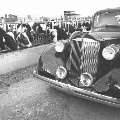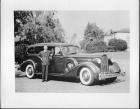|
Re: 1937 roof
|
||||
|---|---|---|---|---|
|
Forum Ambassador
|
"..Was it because they couldn't make a steel stamping that big.." That's it! In 1938, for Packard, the first all steel bodies were introduced.
Posted on: 2013/3/5 14:54
|
|||
|
Mal
/o[]o\ ====  Bowral, Southern Highlands of NSW, Australia "Out of chaos comes order" - Nietzsche. 1938 Eight Touring Sedan - SOLD 1941 One-Twenty Club Coupe - SOLD 1948 Super Eight Limo, chassis RHD - SOLD 1950 Eight Touring Sedan - SOLD What's this?  Put your Packard in the Packard Vehicle Registry! Here's how! Any questions - PM or email me at ozstatman@gmail.com |
||||
|
||||
|
Re: 1937 roof
|
||||
|---|---|---|---|---|
|
Home away from home
|
You got it.Packard did no go to an all steel body until 1938 although I believe the senior cars still had the insert in 38.The 12 still had it in 39 but the super eight was using the 120 body by then.
Posted on: 2013/3/5 14:56
|
|||
|
||||
|
Re: 1937 roof
|
||||
|---|---|---|---|---|
|
Forum Ambassador

|
Another often cited contributor to the longevity of the rubber insert type roof among small volume manufacturers like Packard and Pierce Arrow was, unlike the majors, they built a low number of cars and of several different body styles (and 2 entirely different series for Packard) and amortizing the cost of multiple huge roof dies dies over very low production models (for example, the fixed coupe) was just impossible.
Posted on: 2013/3/5 16:05
|
|||
|
||||
|
Re: 1937 roof
|
||||
|---|---|---|---|---|
|
Home away from home
|
Ford used the rubberized fabric top for many years as did Chevrolet and other manufacturers. I've been told it was the inability to stamp out that large of a piece of metal. Most cars I know of had steel tops by 1936 or 37. If you look at some of the Model A repair manuals, they have very comprehensive instructions on how to install a new top. Chicken wire is the support material, with horsehair for stuffing.
Posted on: 2013/3/5 20:16
|
|||
|
||||
|
Re: 1937 roof
|
||||
|---|---|---|---|---|
|
Home away from home

|
Was the insert always leather or canvas? My 1707's insert almost looks like its a aluminum sheet.
I can understand that they could make a stamping for big roofs, but even coupes have the insert, did the technology not even exist for small roofs?
Posted on: 2013/3/6 7:34
|
|||
|
I can explain it to you but I can't understand it for you
 Bad company corrupts good character! Farming: the art of losing money while working 100 hours a week to feed people who think you are trying to kill them |
||||
|
||||
|
Re: 1937 roof
|
||||
|---|---|---|---|---|
|
Forum Ambassador

|
Was the insert always leather or canvas?
Never heard of a leather or canvas insert, they wouldn't have the water-repellant properties needed. They were a rubber-impregnated and coated fabric cord. If yours is aluminim, it's the result of some later modification.
Posted on: 2013/3/6 9:04
|
|||
|
||||
|
Re: 1937 roof
|
||||
|---|---|---|---|---|
|
Home away from home

|
You know, as long as we're on the subject of bodies...why did it take so long for manufacturers to use "full-width" bodies?
As lovely as separate fenders/running boards look, I wonder why making passenger compartments wider never occurred to manufacturers/stylists until much later. I also wonder why wood-bodied station wagons persisted for so long as well, but that's a separate thread...
Posted on: 2013/3/6 9:28
|
|||
|
||||
|
Re: 1937 roof
|
||||
|---|---|---|---|---|
|
Home away from home

|
The problem with making a 1 piece roof was in getting sheet metal wide enough. The steel mills simply could not make it.
This problem was addressed in 1934. New steel mills began producing wider sheet metal, wide enough to make a whole roof in one stamping. General Motors was the first to take advantage of this with their Turret Top bodies. Cheaper models like the base Chevrolet sedan continued to use the top insert for a couple more years. Even with the steel available, manufacturers had to invest in giant presses and dies capable of making parts more than twice as big as they had ever made before. The roof with fabric insert was made in 4 pieces with short seams at the corners welded together and smoothed over with lead body solder. The 1936 Cord had a one piece roof even though they did not have the presses and dies to make it. The roof was made of 7 stampings, laboriously welded together and the seams filled with lead, then filed and sanded smooth. Very costly and time consuming. This was only feasible on a car that sold for more than a Cadillac. By 1937 only a few cars were still made the old way. The cheapest Plymouths for example. Even there, for a few extra bucks you got a steel insert fitted into the roof instead of the vinyl like oilcloth. Your aluminum insert could have come from the factory or it could have been made up to replace the old fabric. The roof material was an artificial leather or oilcloth that resembled the material used on vinyl tops.
Posted on: 2013/3/7 16:49
|
|||
|
||||
|
Re: 1937 roof
|
||||
|---|---|---|---|---|
|
Home away from home

|
How do I tell if it came of the line with the aluminum insert?
Posted on: 2013/3/7 21:57
|
|||
|
I can explain it to you but I can't understand it for you
 Bad company corrupts good character! Farming: the art of losing money while working 100 hours a week to feed people who think you are trying to kill them |
||||
|
||||








